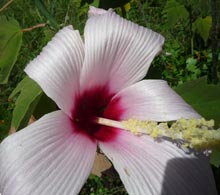
Stella d’Oro
I’m talking about daylilies, of course. Hemorcallis – which are not lilies at all. They’re simply perennials with tuberous roots, much like Agapanthus.
They are among the most cultivated species in the world. As of 2022, there were more than 89,000 registered cultivars. And that’s in America alone.
Daylillies must be the toughest plants known to man. I left some unplanted daylily roots behind my garage for years. When I found them, I replanted them anyway, and they bloomed beautifully.
There are three distinct types of daylilies: dormant, semi-dormant, and evergreen. We can grow successfully the semi-dormant and evergreen, but the dormant sometimes doesn’t do well because we don’t usually have enough cold weather to give it the dormancy that it needs to come back and re-bloom each year. Unfortunately, the dormant ones are among the prettiest ones, so pick the coldest spot in your garden, and try them anyway.
When shopping for a daylily, take your phone along because the plant label will not tell you which of the three types it is. You can go to the website of the American Daily Society, and it will tell you what cultivar it is: dormant, semi-dormant, or evergreen.
It should also tell you whether or not it is a re-bloomer. Some of these re-bloomers will bloom in spring and again in fall. Others have a succession of bloom periods, one shortly after another for several months.
Each flush of daily blooms lasts from one to five weeks, depending on the variety. Some begin blooming as early as March in southern climates. Others wait until the end of summer to begin blooming. They’re known as early, mid-season and late season bloomers. With proper planning, you can have daylilies in bloom from early spring until late fall.
You can even choose how tall you want them. They come in short, medium, tall and really tall ones with willowy stems that can reach 30 inches. Ones with short, fat petals, petals with ruffles, and ones with long narrow petals and whose blossoms can be as big as your hand!
I don’t know of any easy care species that has such a huge variety of heights, flower shapes and colors.Except blue.
I could get all technical with you and talk about diploid and tetraploid daylilies, but I won’t. Thank goodness! But I will say that little men in white coats have been working for years developing them to have stronger stems and thicker petals making a more robust plant altogether.
My very favorite flower type is the spider type. They’re usually quite tall with long, narrow, sometimes curly, petals in all the daylily colors. Great back of the border plants.
While they are mostly propagated by dividing the clumps, there is an unusual method that you can’t do at will. You have to wait for the plant to let you know when it’s ready. A new plant will appear along the flower stem. It’s actually a tiny plant, complete with roots, that can be severed from the stem and planted.It’s called a “proliferation” and is quite rare in horticulture.
Since its introduction in 1975, ‘Stella d’Oro’ has become the most popular daylily in America. It has been called the perfect perennial. It has large, profuse and fragrant yellow blossoms all season long, lovely evergreen foliage, and comes back reliably every year. What more could you ask of a plant?
Well, for one thing, I would ask that the yellow be toned down somewhat so that it was not such a glare in the garden. Best used with other hot colors.
And so I’ve found the answer to the bright yellow ‘Stella d’Oro’ daylily . ‘Happy Returns’ has all the attributes of ‘Stella d’Oro’ but its blossoms are a clear butter yellow. Huzzah! Can’t wait for spring!









